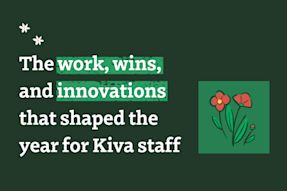Throughout 2020, two things became clear to us at Kiva:
2020 Results and Learnings: Our work in the U.S. is more critical than ever. Few organizations can make scalable, small-dollar loans at zero interest, zero-fee.
2021 Path Forward: We require hundreds more national and regional partnerships to deliver on the scale needed to end financial exclusion here at home.
2020 Results
Due to unprecedented borrower demand and the stinging reality that many American small businesses were struggling to survive in the midst of COVID-19, Kiva doubled down on its U.S. mission in 2020 of building a portfolio of 10,000 small businesses. We channeled nearly $8M in impact-first capital from individuals, communities and corporations to as many financially excluded entrepreneurs as possible - with a particular focus on BIPOC entrepreneurs to address the persistent racial wealth gap and uneven distribution of the PPP loan program.
In particular, we focused on 1) scaling the number of borrowers we serve 2) growing our base of Kiva Hubs (community-based non-profits, CDFIs, and city governments) to provide support and technical assistance, 3) improving core technologies and underwriting operations for our new scale, and 4) building our lending capacity with individuals and corporate partners (PayPal, Wells Fargo, Bank of America, Doordash, Walton Foundation to name a few) in order to meet increased demand.
Throughout the year, we adapted to help businesses survive:
- Larger loans: The maximum loan on the Kiva platform increased from $10,000 to $15,000 with a handful of $25,000 loans for repeat borrowers and American farmers.
- Grace period: Borrowers could access a grace period of up to 6 months for greater financial flexibility.
- Flexibility: Deferments of defaults and a ‘pay what you can’ approach with borrowers that fell behind in repayment.
In 2020, Kiva U.S. entered a new phase of growth by activating over 250,000 lenders and our partners to fund 1,109 borrowers across 47 states and 3 territories in the United States. Totaling $7.9M, this represents the largest single-year since the inception of Kiva U.S. in 2012 —a ~70% increase over 2019. This brings Kiva’s total US lending to $42M across 6,920 entrepreneurs.
Here’s a snapshot of the entrepreneurs we lent to in 2020:
- 67% are women
- 64% are people of color
- 37% are Black
- 17% are immigrants or refugees
- 51% either have a credit score below 650 or don’t know their credit score
Additionally, Kiva U.S., in partnership with 10 CDFIs, helped launch the California Rebuilding Fund, an innovative, public-private partnership aggregating funding from private, philanthropic, and public sector sources – including an anchor commitment from the State of California’s Infrastructure and Economic Development Bank (“IBank”) – to address the capital and advisory needs of California’s small businesses as they reopen and recover from the COVID-19 health and economic crisis. The California Rebuilding Fund has funded over $15M in loans to date and we plan on collectively funding $50M+ in the coming months.
Key Learnings from 2020
As we reflect on 2020, we wanted to share some of our key learnings that will inform our work and that of the U.S. microfinance sector moving forward.
- Systemic barriers laid bare the need for Kiva U.S.: Our “capillary” banking system does not effectively reach low-income and minority-owned businesses. According to the Center for Responsible Lending, "roughly 95% of Black-owned businesses, 91% of Latino-owned businesses, 91% of Native Hawaiian or Pacific Islander-owned businesses, and 75% of Asian-owned businesses stand close to no chance of receiving a PPP loan through a mainstream bank or credit union.” For Kiva US in 2020, 1 in 3 of the businesses we support are Black-owned, 2 in 3 are owned by BIPOC entrepreneurs.
- Americans want to lend a hand locally: We crowdfunded loans at a record pace (~15 days to fund). Kiva is predominantly an international lending platform, but we saw a marked increase in Americans wanting to support their community this past year.
- Local partners are key: Kiva U.S. expanded to 29 Hubs serving 40 American cities in 2020. These Hubs are CDFIs, community non-profits and city governments that deepen the impact of the Kiva U.S. program. By building trust with local communities, supporting the application and repayment process, and providing technical assistance, these high-touch, community-level partnerships result in improved outcomes: higher impact borrowers and higher repayment performance. Kiva U.S. also strengthened its continued partnership with LISC, helping us match borrower loans across the U.S.
- American companies want to support American Small Businesses: Tech-companies like Turo and DoorDash are partnering with Kiva to fund entrepreneurs in their ecosystem. Large scale financial institutions like Bank of America and Wells Fargo are matching loans with U.S. borrowers. A key way to reduce Kiva’s existing cost of reaching new borrowers will be through corporate partnerships that share us as a tool within their entrepreneurial communities.
- Not just a capital boost, but a confidence boost: Especially after entrepreneurs experienced such an isolating year, borrowers again and again speak to the powerful boost they receive from being supported by strangers across the Kiva community.
Here’s what Angery said after getting a $15,000 loan by 215 lenders on Christmas morning:
"As we sip from our mugs and watch our children unwrap the presents, I couldn't avoid the temptation of checking the status of our application - and boom - we had been fully funded! More importantly, despite all of the bad things that are happening in the world, we had the feeling we are NOT alone. THANK YOU, not just for your loan but for reminding us that there are people out there who want to see us succeed. Thanks to our customers, friends and family - and those who didn't know us yet trusted us with their hard-earned dollars. We will put these funds to good use and not only repay this loan, but pledge to become a supporter of other people on this platform."
2021: Path Forward and Support
In 2021 we aim to replicate the growth we saw last year and continue to step into our role of providing an affordable first rung of the capital ladder to the ~1.5M small business owners that lack access to equitable, ethical lending. We strive to do this with an 80% repayment rate. We will continue focusing our efforts on sourcing and lending to entrepreneurs such as Jermaine, a veteran in Bentonville, AK, or Kelsey in Atlanta, GA.
To grow our lending capacity and source our target businesses, we will continue the following in 2021:
- Larger loans are here to stay: 2020 was our first year consistently offering loans over $10,000, and they accounted for nearly $2M of overall lending. In 2021 we will continue to consistently offer loans up to $15,000 - and potentially larger.
- Repayments will be tested in 2021: So far, we only saw a modest decline to our existing 80% U.S. repayment rate, but the payback periods of most of our 2020 lending is beginning. Empathetic collection and facilitating communications between borrowers and lenders will be key as repayments drive the cycle of funding other borrowers.
- Expanding the understanding of “creditworthy”: Credit scores and two years of tax returns as the narrow basis for underwriting fail for too many Americans. Kiva U.S. and others continue to prove that cash flow analysis, community collateral and social underwriting are working to identify more credit-worthy businesses. As a step on a broader path to capital access, we plan to roll out opt-in credit reporting so that borrowers can build a history of business credit.
- Kiva’s lenders react to loan matching: Our individual lenders (average loans of $27) fund loans at a much higher rate on days where loan matching is available from a corporate partner (which account for ~35% of Kiva U.S. loan funding). Given this and the fact loan matching reduces the days to fund for the borrower, Kiva U.S. will strive to significantly increase its managed lending assets under management.
Thanks so much for reading our update and for continuing to be a part of the work we’re doing to further economic and racial justice. As we enter 2021, if you are interested in channeling Kiva lending on behalf of entrepreneurs, we’d love to partner.
How You Can Support Kiva U.S.
- Lend to a US borrower, or better yet, set up Monthly Good: At any given time, there are 25-50 entrepreneurs spread across the U.S. seeking, that are ready for lender support. You can find them here, or set your account to lend monthly—reliably fueling American dreams.
- Share our loan offering with the small businesses you love: Literally anyone can be part of the Kiva ecosystem—whether as a lender or a borrower. We’re seeking partners to help us spread the word about the work that we do.
- Set up a local Hub: Communities that lack access to capital can set up a local Hub to grow Kiva’s lending to that geography. Community-based partners, local foundations and locally headquartered companies can team up to grow impact.
- Create a Managed Lending Fund: Partners can lend and recycle their capital to directly fund entrepreneurs through the Kiva platform. They exponentially grow the rate of fundraising for the borrowers by 1:1 matching each lender contribution.
- Help us build operational capacity: As a non-profit, Kiva U.S. seeks operating grants to invest in technology and our team, allowing for further efficiency and innovation toward our mission.
If any of the above opportunities are compelling to you, your organization, or perhaps someone you know, please do reach out to us! You can email Rohit Agarwal (RohitA@kiva.org) and/or Katherine Lynch (KatherineL@kiva.org) to discuss ways to partner.
Thank you for reading and we’re looking forward to growing in 2021 together.
Onwards,
Kiva U.S.
PREVIOUS ARTICLE
COVID-19 impact and updates: listening, adapting, and learning into 2021 →NEXT ARTICLE
Volunteer spotlight: “It’s amazing to understand the triumphs and challenges of people around the world” →














